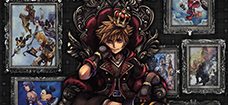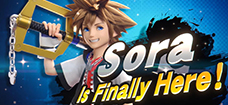|
Kando: What kind of work do you generally do for The World Ends With You?
Hasegawa: Let’s first cover Mr. Kando’s duties as a director.
Kando: Being a director, well, is basically doing chores (laugh).
Hasegawa+Arakawa: (laughs)
Hasegawa: Saying that you do chores doesn’t sound like you work at all. Please, clue us in a little.
Kando: Well, I first oversee the entirety of the project and give directions where it’s needed. It’s basically my job to grasp the contents of the project and to keep it moving forward. When it comes to the heart of production, I concentrate mostly on the scenario. I also recheck the entire project and read through the dialogue near the end. What about you, Hasegawa?
Hasegawa: The three of us have taken on multiple tasks since beginning this project, but I was more in charge of the graphics.
Kando: I remember when Hasegawa sent in the first designs for Noise.
Hasegawa: Right, from concept to completed design.
Kando: Now, Arakawa.
Arakawa: My job title is Planning Director. Everyone has an idea of what they want to do, and I’m the one that sorts through those ideas (laugh).
Kando: Everyone says whatever they want without any consideration.
Arakawa: I basically shape the product, in a way.
Kando: The three of us have been the main staff members for a while, but there were definitely parts in the project that we just came up with on the spot, without a formal plan.
Hasegawa: That’s true.
Kando: We’re not so used to planning since we’re graphics oriented.
Hasegawa: Right (laugh).
Kando: Arakawa was really helpful to us since he was the only one with planning experience.
Hasegawa: I remember suggesting some things for the game and he thought of ways to work it into the game.
Kando: So, we’re the three responsible for kicking this game off.
Arakawa: Right.
Kando: Sure has been a long time. The World Ends With You has taken a really long time.
Arakawa: Two and a half years ago, while we were working on KINGDOM HEARTS II.
Hasegawa: We hadn’t even seen a DS unit then.
Arakawa: I remember how we wondered how the touch screen would work (laugh). We knew that we had to use the touch screen but didn’t know how.
Kando: There are surely people who haven’t played this game, so let me briefly explain. The DS has two screens, and this game not only uses one screen for battle, but two. We thought that it’d be interesting to have a game where both screens were packed with action, and that’s how we formulated this game idea.
Arakawa: Two screen battle, the Stride Cross Battle.
Kando: We previewed a playable demo at the 2006 Tokyo Game Show.
Arakawa: The people who played it were really taken to it.
Kando: They really were.
Hasegawa: It may look confusing when you read about it in magazines, so I really insist everyone to try it out on the DS.
Kando: We tried to materialize the idea of having battles on both the top and bottom screens, so the battle system was created with that in mind.
Arakawa: How about the game world?
Kando: Well, we still have a lot of old Square Soft employees (before becoming Square Enix), and we noticed that we don’t have a lot of games that take place in the present. The closest candidate is Front Mission.
Arakawa: Just barely, really.
Kando: So we thought that it’d be interesting to make a game set in modern-day Shibuya, which is a lot different from the usual fantasy worlds.
Hasegawa: Definitely a change compared to our other games.
Arakawa: Everyone’s working on FINAL FANTASY, so it’s nice to work on something else once in a while (laugh).
Kando: We’ve been working on big titles like FINAL FANTASY and KINGDOM HEARTS for a while now, so with this smaller title on the unique DS system, we’ve taken the opportunity to explore a little more than usual in terms of direction. We still put as much effort into it as some of the bigger titles.
Arakawa: They sure give us a lot of freedom on this title… They gathered the three sci-fi monster movie geeks to work on it (laugh).
Kando: Monster geeks! (laugh) You make us sound like oddballs! (laugh)
Hasegawa: There’s no way that they grouped us together for that reason (laugh).
Kando: In any case, it went something like this.
Arakawa: I remember how we all planned about the DS for the first month.
Kando: It was purely research in the beginning.
Hasegawa: We set forth to shatter the idea of the conventional video game.
Arakawa: They gathered us, three graphic artists, into a team so we thought that we should make something visually striking. I remember consciously reminding myself that.
Kando: I’m sure that they found the idea of grouping three graphic artists interesting. We did a lot of brainstorming and planning, and by the end of the year we were increasing in team size, and they started to join the brainstorming.
Arakawa: We’ve been working with [the game studio] Jupiter for a while now. We’re pretty in sync with Jupiter.
Kando: That’s for sure, it’s as if we were working on parallel schedules.
Arakawa: The meetings were mostly brainstorming sessions.
Kando: Our staff and the Jupiter staff, just brainstorming.
Arakawa: We spent two and a half years like that (laugh). The conception of the game took the most time. We sure had a small team in the beginning.
Hasegawa: It was harmonious.
Kando: When we took a step back, it was surprising how much we had to do. For maps, Shibuya isn’t particularly large, but there were a lot of elements within that, such as battle locations, field areas, shops, badge items, etc.
Arakawa: There are a lot of things in this game.
Kando: Mounds of it.
Arakawa: It started out as such a compact game (laugh). But once we opened the flood gates… Well, it’s still a very tightly knit game, I think. There was just a lot to do development-wise.
Kando: We kept adding things that we wanted in there.
Arakawa: We sure did (laugh).
Hasegawa: There were things that we thought of giving up on, or scrapping an idea altogether, but most everything was implemented.
Arakawa: I debated on scrapping a few things, but no one wanted to do that (laugh). They kept saying how they’ve done so much already and that it’d be a waste not to keep it, so I had no choice but to agree. I remember how we considered scrapping items altogether (laugh).
Kando: Then we’d say something like “no we should keep it.”
Arakawa: And we go, “yeah well, of course we should.”
Kando: But the end result is good, and that’s what counts.
Arakawa: That’s true. I’m glad that everything made it. It’s just that the more we put in, the more adjustments we need to make (laugh).
Kando: Fine tuning is definitely important. Even the music, they were made with the game’s story and ideas in mind.
Hasegawa: The music really goes well with the game.
Kando: The music goes great with the game. I think it’s a major attraction of the game (laugh).
Arakawa: It’d sure be nice if everyone could listen.
|







